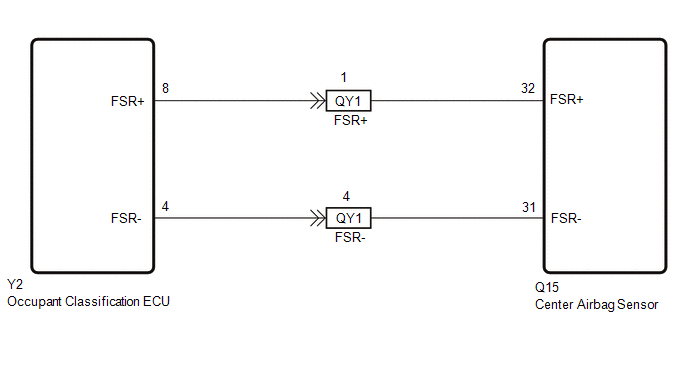DESCRIPTION The center airbag sensor communication circuit consists of the occupant classification ECU and the center airbag sensor. DTC B1790 is set when a malfunction is detected in the center airbag sensor communication circuit.
HINT:
WIRING DIAGRAM 
CAUTION / NOTICE / HINT NOTICE:
HINT:
PROCEDURE
(a) Turn the ignition switch to ON, and wait for at least 60 seconds. (b) Clear any DTCs stored in the memory (Click here
HINT:
(c) Turn the ignition switch off. (d) Turn the ignition switch to ON, and wait for at least 60 seconds. (e) Using the Techstream, check for DTCs of the occupant classification ECU (Click
here OK: DTC B1790 is not output. HINT: DTCs other than DTC B1790 may be output at this time, but they are not related to this check.
(a) Turn the ignition switch off. (b) Disconnect the negative (-) terminal cable from the battery, and wait for at least 90 seconds. (c) Check that the connectors are properly connected to the occupant classification ECU and the center airbag sensor. OK: Connectors are properly connected.
(a) Check that the connectors (on the center airbag sensor side and occupant
classification ECU side) are not damaged (Click here
OK: Connectors are not deformed or damaged.
(b) Turn the ignition switch to ON. (c) Measure the voltage according to the value(s) in the table below. Standard Voltage:
(d) Turn the ignition switch off. (e) Disconnect the cable from the negative (-) battery terminal, and wait for at least 90 seconds. (f) Using a service wire, connect terminals 32 (FSR+) and 31 (FSR-) of connector B. NOTICE: Do not forcibly insert the service wire into the terminals of the connector when connecting a service wire. (g) Measure the resistance according to the value(s) in the table below. Standard Resistance:
(h) Disconnect the service wire from connector B. (i) Measure the resistance according to the value(s) in the table below. Standard Resistance:
(a) Connect the connectors to the occupant classification ECU and the center airbag sensor. (b) Connect the negative (-) terminal cable to the battery, and wait for at least 2 seconds. (c) Turn the ignition switch to ON, and wait for at least 60 seconds. (d) Clear any DTCs stored in the memory (Click here
HINT:
(e) Turn the ignition switch off. (f) Turn the ignition switch to ON, and wait for at least 60 seconds. (g) Using the Techstream, check for DTCs of the occupant classification ECU (Click
here OK: DTC B1790 is not output. HINT: DTCs other than DTC B1790 may be output at this time, but they are not related to this check.
(a) Turn the ignition switch off. (b) Disconnect the negative (-) terminal cable from the battery, and wait for at least 90 seconds. (c) Replace the occupant classification ECU.
HINT: Perform the inspection using parts from a normal vehicle when possible.
(a) Connect the negative (-) terminal cable to the battery, and wait for at least 2 seconds. (b) Connect the Techstream to the DLC3. (c) Turn the ignition switch to ON, and wait for at least 60 seconds. (d) Using the Techstream, perform the zero point calibration (Click here
(a) Using the Techstream, perform the sensitivity check (Click here
Standard range: 27 to 33 kg (59.5 to 72.8 lb)
(a) Connect the negative (-) terminal cable to the battery, and wait for at least 2 seconds. (b) Turn the ignition switch to ON, and wait for at least 60 seconds. (c) Clear any DTCs stored in the memory (Click here
HINT:
(d) Turn the ignition switch off. (e) Turn the ignition switch to ON, and wait for at least 60 seconds. (f) Using the Techstream, check for DTCs of the occupant classification ECU (Click
here OK: DTC B1790 is not output. HINT: DTCs other than DTC B1790 may be output at this time, but they are not related to this check. Result
(b) Connect the cable to the negative (-) battery terminal, and wait for at least 2 seconds. (c) Turn the ignition switch to ON. (d) Measure the voltage according to the value(s) in the table below. Standard Voltage:
(e) Turn the ignition switch off. (f) Disconnect the cable from the negative (-) battery terminal, and wait for at least 90 seconds. (g) Using a service wire, connect terminals 32 (FSR+) and 31 (FSR-) of connector B. NOTICE: Do not forcibly insert the service wire into the terminals of the connector when connecting a service wire. (h) Measure the resistance according to the value(s) in the table below. Standard Resistance:
(i) Disconnect the service wire from connector B. (j) Measure the resistance according to the value(s) in the table below. Standard Resistance:
|
Toyota Tundra Service Manual > Front Drive Shaft Assembly(for 4wd): Installation
INSTALLATION CAUTION / NOTICE / HINT HINT: Use the same procedures for the RH side and LH side. The procedures listed below are for the LH side. A bolt without a torque specification is shown in the standard bolt chart (see page ). PROCEDURE 1. INSTALL FRONT DRIVE SHAFT ASSEMBLY LH (for Front Differ ...